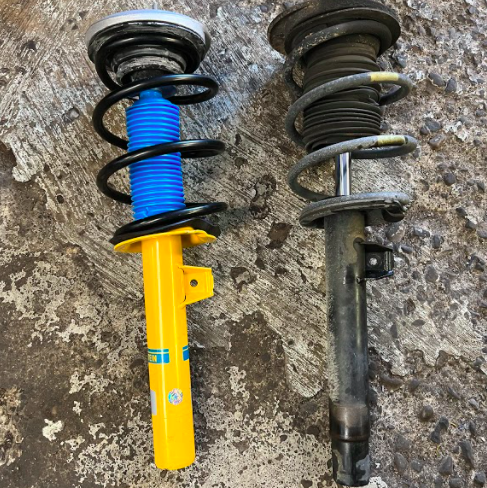New Suspension Made My 284,000-Mile M3 Project Car Feel New Again
Last summer I bought an E46 M3 coupe with an incredible 284,000 miles on the clock. Though the car looked healthy on the surface, it didn’t take long behind the wheel to discover just how much work it needed. While the engine was healthy, most of the rubber holding the car together had long since deteriorated. The front brakes were in desperate need of attention, and the tie rods were shot. I’ve spent the last few months replacing those things, but one major item remained: The suspension. Now, after installing new shocks and springs, the car finally drives like new.
It was obvious from the first time I drove this car just how badly it needed a suspension refresh. Two of the car’s shocks were totally blown out and leaking, while the springs were tired and sagging from nearly 300,000 miles of use. The car felt crashy over any surface that wasn’t glass-smooth, a hammering of thunks was heard over every bump. It sounded like the shocks weren’t even there. It was getting to a point where I would avoid driving the car simply because the ride was so bad.
My goal with this M3 was to turn it into a fun daily driver, so I wanted to retain the stock ride height rather than lose a few inches with a set of high-quality coil-overs. So I turned to FCP Euro and bought a full suspension replacement kit that came with new shocks, springs, and all of the associated top hats and mounting hardware. I could’ve opted for the OEM Sachs shocks, but I wanted a sportier ride, so I opted for Bilstein B6 units instead. That way when this car eventually sees back roads and autocross courses, it’ll be a bit sharper through corners.
Replacing the shocks and springs on an E46 is straightforward. On the front all you have to do is unbolt the sway bar end link, drop the shock body from the knuckle, and unbolt the top hats from the shock towers. Separating the shocks from the knuckle was the most difficult bit, but thankfully I had a friend around to lend a bit of muscle. Removing the shocks and springs from the rear is even easier; there are just three bolts holding each shock to the car—two in the trunk, and one at the knuckle. And to get the springs out, all you have to do is push down on the hub assembly and pull them from their perches. The whole job took me just a few hours, including the time it took to assemble the new front uprights.
Out of all the repairs I’ve done on this BMW, this new suspension has had the biggest improvement in on-road feel. I no longer find myself trying to avoid small bumps in the road or bracing for impacts. Sure, the ride is still a bit stiff, but I expected that from the sporty Bilsteins. The important thing is that the shocks finally work like they’re supposed to, rebounding from compressions rather than sitting there and doing nothing. It’s a night-and-day improvement over the worn-out original equipment.
It’s the middle of winter here in New York right now, so I haven’t had the chance to take my M3 on a back road or a race track to test the improvements. But judging by how nice it feels to drive the M3 down a highway, I have high hopes. Before I tackle stuff like the cooling system and subframe mounts, I want to take this car on a road trip, possibly to somewhere with a more temperate climate, to see how well it handles a big trip. Stay tuned.
This content is created and maintained by a third party, and imported onto this page to help users provide their email addresses. You may be able to find more information about this and similar content at piano.io




